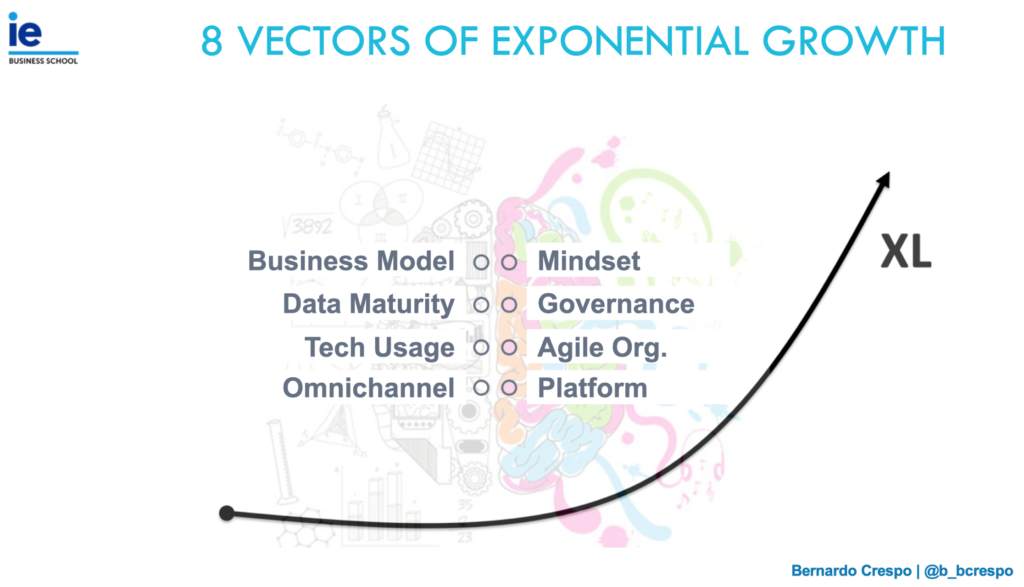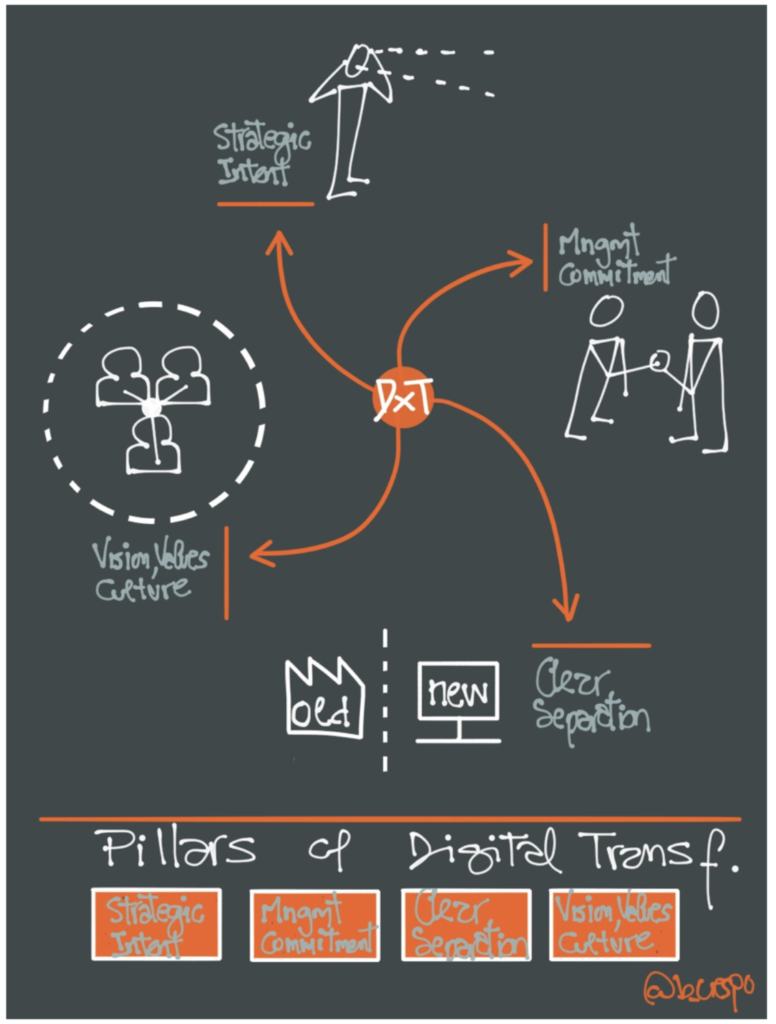Do you know any Digital Transformation consultants? It is not an unusual question and not negligible. This is the challenge posed by anyone who has already bought the reason why for change management.
I already know that I have to transform my business and I want someone to walk along with me now. At the outset, I want to recall for you an analogy I made years ago about the stages of digital transformation and the learning stages of any new skill.
Recognizing that I need to face change is the closest thing to the transition from the initial phase of “Unconsciously Incompetent” to “Consciously Incompetent.” It may sound arrogant but is the best gift any decision maker can make: “I have internalized that I have a lot to learn”.
This << transformational penny drop >> is the explicit recognition that there is a huge improvement space to face. the fact of realization is the best gift. However, any business model change management requires connecting parts (as Lego bricks) and construction is an exciting game that never ends. I am afraid there is no standard solution for all businesses. And there are some common elements to start and move forward along the way.
When someone tells me that “I need a digital transformation consultant”, this is what I hear:
- “You have understood the lesson that speed of change makes your business no longer secure in 2-5 years (…)
- You recognize that there are parts of your business that can be automated (…)
- You discover that your desirable business vision is far from what most executors have in mind in your current business model. (…)
- You have fully assumed that actual data usage in your company can be improved. (…)
- And also that your legacy technology is expensive, unfriendly and lacking in many functionalities that exist in the market for a significantly lower price. (…)
- You have reflected that organizational model designed years ago no longer serves for an uncertain environment where historical data series no longer work as before to discount future cash flows as if we were in a true certain scenario (…)
- In addition, you admit that your current view of your market, your customers and your competitors is a limiting vision of what you can achieve if you generate collaboration spaces beyond your industry. (…)
- You even wonder if the team that brought your company to where it is now will ever be useful for the future you have foreseen. Moreover, you do not know exactly what kind of new talent will be required. “
Let me translate what I hear into a jigsaw to be completed. You request the best advice -without further knowing your business- and a set of 12 “hows” to draw a simple deconstruction of the milestones of digital transformation:
- How to translate your vision into a statement, a manifesto appealing enough to persuade all teams responsible for managing the change.
- How to build a roadmap from that vision and translate it into strategic indicators that allow for the planning of deliverables and desirable results.
- How to set a scorecard comprising all strategic indicators in order to guide you through a flexible fulfilment of your roadmap translating simultaneously your KSIs into financial lingo to facilitate your vision to your CFO.
- How to capture your vision and model it into the strategic design of your future business model. A new business model that will run together with your current P&L. Additionally, you ask me how to inoculate the continuous improvement virus to your current business as well as in the evaluation of future business models.
- How to audit current use of data points and how, according to your vision, we can translate emerging technologies into new ways to enrich your vision, supporting at the same time each new initiative with new data sources and new Insights all through a bold data strategy
- How to accommodate the vast supply of technologies to best implement each solution to each corner of your current value chain. Establishing a new flexible architecture model compatible with the endless choice of available SasS solutions.
- How to design the best mix of talent, data and technology to redefine the current distribution model by focusing on the one who pays the bill -customers.
- How to reflect on the governance model that should lead the current business model and at the same time boost, without friction, new revenue streams that contribute to balance your future P&L in a not too distant future.
- How to use communications to your team responsible for the proliferation of your new business, generating emotional engagement and willingness to change.
- How to keep alive the flame of the team and how to generate collaboration dynamics beyond your company, your sector and your network.
- How to use people analytics in order to best allocate human resources to every initiative within your strategic roadmap.
- How to emerge processes from collaborative agile dynamics to optimize roadmap deliverables.
Finally, how to translate this new journey towards a desirable vision that goes beyond your industry and also nurtures with financial arguments the sustainability of current and future business model. In other words, how to translate the current linear business model into a proposal that accommodates customers and suppliers, able to generate multiple business models that minimize your cost structure anchored in a limited vision by your current supply chain.
This is a bold script on change management. Any other approach to the challenge of transforming your company may only fill part of what digital transformation entails. And it will be a necessary condition. And just that.
If you want to translate all these reflections into a visual and easy to remember stack, here it goes:
Do you know any digital transformation consultant? No, I’m afraid not. I do not know any male or female superhero who can help you on the above roster and leave you in a comfortable client-supplier.relationship.You have to take a leading role. You must co-build together (internal and external help) and you will need a clear vision and a flexible execution model.
And as for when to start, I can only tell you that if it starts tomorrow you will have lost today and you will have won 6 days compared with starting next week.
Before starting, ask yourself the following four questions:
- Do I have a unique and determined commitment to question everything that has taken me where I am?
- Do I have the C-suite level support and commitment to face the change according to the new vision?
- Am I willing to spin out a new business model if necessary?
- Am I capable of assuming that this change is a profound review of vision, culture and values in my company?
Source: Michael L. Tushman et al. “Lead and Disrupt: How to Solve the Innovator’s Dilemma” 2016
If you answer affirmatively to the previous four questions, you are ready to begin.
And with respect to your question, do you know any Digital Transformation consultant? – I DO have names who can help you through. Starting with you coz you had the vision initially and because change management and business transformation can not be delegated at a leadership level.
“Every great dream begins with a dreamer. Always remember, you have within you the strength, the patience, and the passion to reach for the stars to change the world”. – Harriet Tubman
Dedicated to all my students at 6th edition Digital Transformation Executive Program at IE Business School: Mar Aguado, Humberto Bedolla, Fran Cantos Llopis, Jaime García Cruz, Paco Marcano, Borja Marcos, Emilio Martínez, Nuria Pardo, Javier Parra Gómez-Acebo, Paolo Piva, Diego Prado, Juliana Salazar, Lucía Schmid, Cristhian Schmidt Solis
My special gratitude goes to Susana Rodríguez Urgel as academic co-director.
Article by channel:
Everything you need to know about Digital Transformation
The best articles, news and events direct to your inbox
Read more articles tagged: Change & Transformation, Featured









